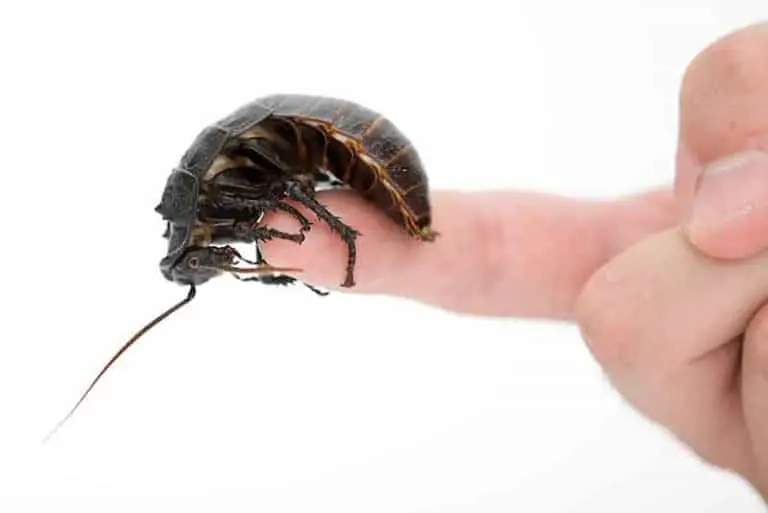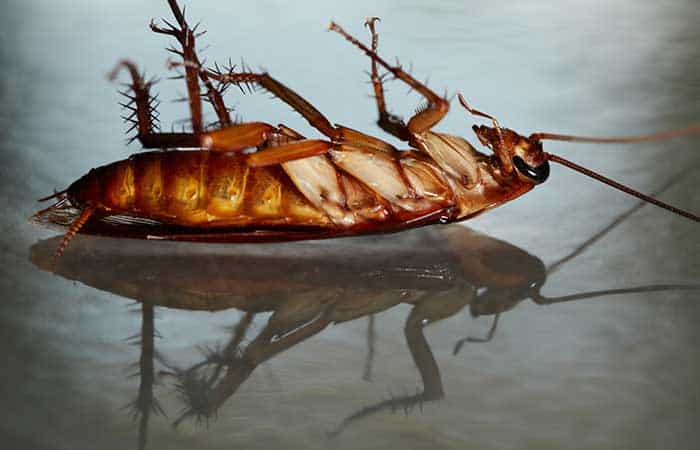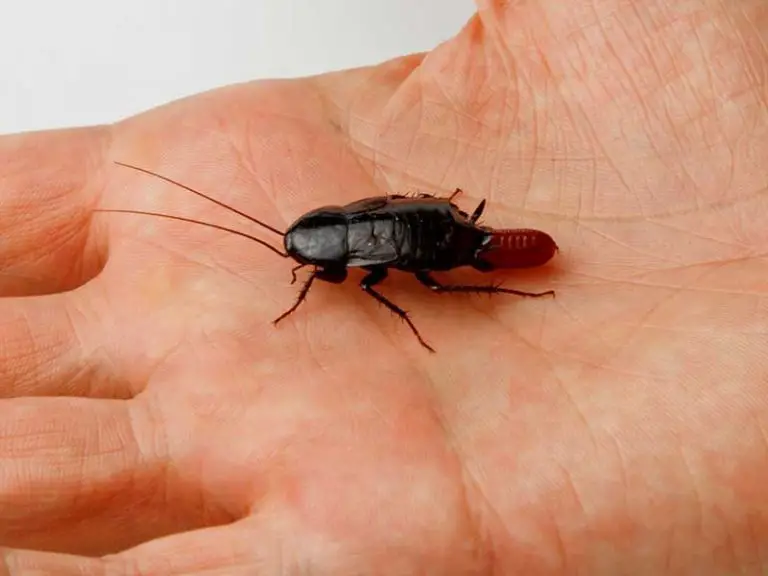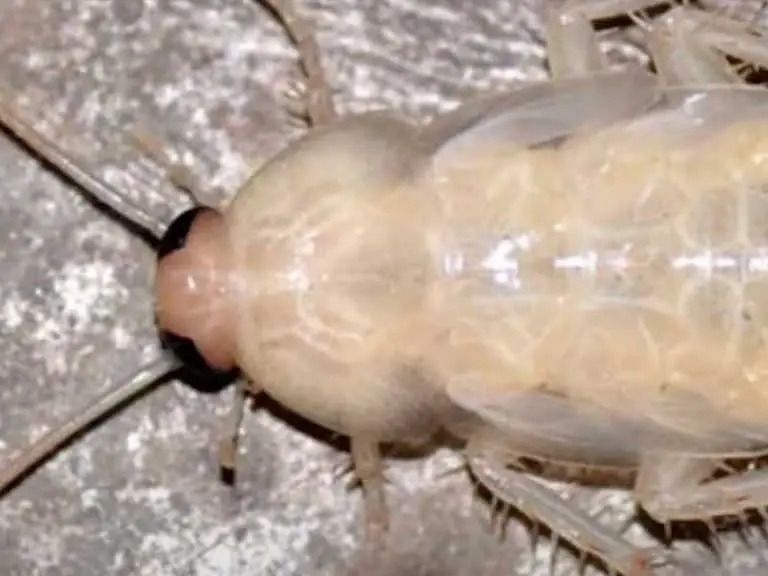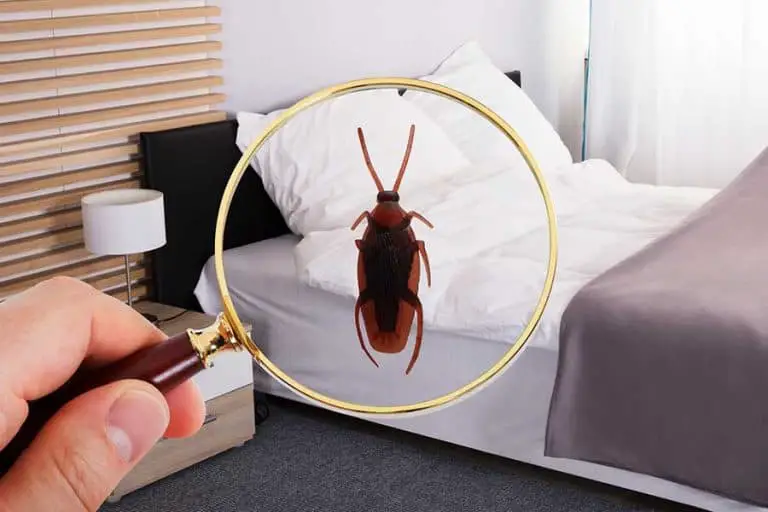How Many Legs Do Cockroaches Have?
Cockroaches are an insect which means they have six legs. Because all insects have six legs (remember spiders are arachnids, not insects), this fact alone will not help you to identify a cockroach. In this post, we consider a cockroach’s anatomy in detail to be sure you are correctly identifying them.
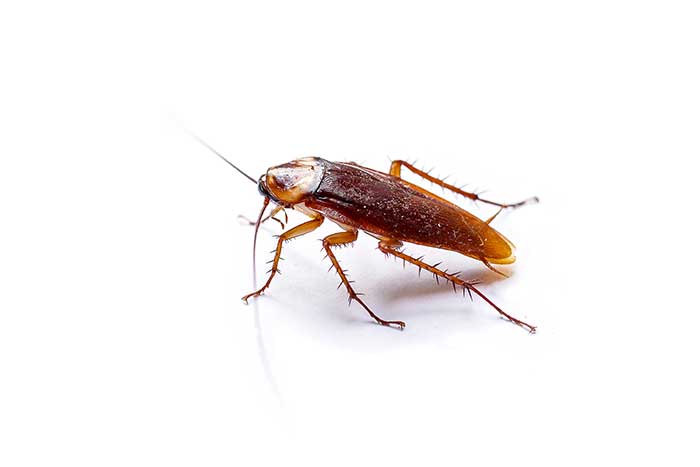
The Anatomy of a Cockroach
We will consider each section of a cockroach’s body and other insects that look similar so that you can tell the difference. Correct identification of pests is crucial because it allows you to control them more effectively. Proper identification of a cockroach will require close examination, as we will explain towards this article’s end. Let’s start by looking at the anatomy of a cockroach, section by section.
Cockroach Legs Explained
Cockroach legs come in three pairs. All of the legs are spiny, slender, and jointed. Each pair is attached to a segment of the torso or thorax. Each pair of legs serves a different purpose and, therefore, has a different name.
The prothoracic legs are located directly behind the cockroach’s head. These are the shortest of all the legs, and a cockroach uses them to slow itself down. Sometimes, these legs are so small that they’re hidden, making it look like the roach only has four legs.
You can find the mesothoracic legs in the middle of the cockroach’s body. A roach uses these legs to help adjust its speed to slow down or up as required.
The metathoracic legs are located at the rear of a cockroach. These legs are strong and used to propel the cockroach forward quickly, helping it reach incredible speeds of up to fifty body lengths a second.
A cockroach alternates its steps in a specific way to maximize its mobility, even on rugged terrains. As it walks, a cockroach moves its front and back legs on one side while its middle legs are opposite.
Cockroaches take longer, slower strides to maintain contact and avoid falling when they walk upside down on a ceiling. This ability takes immense care and energy, which significantly reduces its pace. They are also capable of walking backward but will not be as fast or agile while doing so because their front legs do not have the back ones’ design to propel them quickly.
Can Cockroaches Regrow Legs?
Cockroaches are among some of the most adaptive insects on earth and can survive in the most inhospitable places and have biological features that almost make them invincible.
You may notice a cockroach with fewer than six legs. They can survive and move around even after losing a leg or two. In the case of lost legs, the roach may seem more haphazard in its movements. However, they do have an incredible ability to regenerate lost legs, so they will usually return to the six-legged norm after some time.
The fact that it’s possible for cockroaches to regrow legs has been known to entomologists since the early 1900s. Regrowing lost limbs doesn’t seem special when you’re talking about insects because many of them can do it. The reason why this is possible has to do with the way their nervous systems are structured. Their nervous systems are extremely simple, which makes them easier to study. It also means that cockroaches can survive with quite a few missing neurons, so they have some leeway if their limbs get chopped off.
The ability to regenerate legs is truly an amazing feat of biological engineering. The cockroach’s exoskeleton acts like its skeleton and also protects it from predators. If a leg is lost, it can’t grow back outside of the pupal stage. In order for the cockroach to regrow its legs, molting must take place because its body needs to shed its current shell in order for a new one to form. This process does not heal any broken appendages, however–in this case, a lost leg is truly gone.
There’s one more thing to consider about cockroach legs. When you see the six-legged insect, three of its legs are attached to its thorax (the middle part of its body), and the other three are attached to its abdomen. If it loses a leg, it will usually regrow the same type of leg in the same spot. But cockroaches aren’t like humans; their legs are not symmetrical, so it’s possible for them to have different types of legs on one side than they do on the other.
Cockroach legs are made to be strong and highly flexible due to the resilin located inside. Resilin is a protein that is similar to rubber and it helps cockroaches bend their legs and run with ease. It also stores energy, like a spring, which gives the roach extra power to escape from predators. This resilin makes them fast runners and great jumpers.
Ready for another amazing feature? You might want to make some popcorn first: some cockroaches can run up to three miles per hour (that’s faster than you). One stride is equal to about half an inch.
If cockroach’s legs were any bigger they wouldn’t be able to fit inside their shells, so if it loses a leg or two, it won’t make much of a difference in its overall speed.
So, can cockroaches regrow legs? The answer is yes. They have the ability to do so, but it’s not an instant process. It generally takes about a month for them to grow back just one leg at a time. Their ability to regrow lost limbs comes in handy because some species are able to shed their outer shell.
This is particularly significant in times of stress, so being able to regrow their legs after losing them makes the process of molting easier. They are also able to get rid of an entire limb if they need to escape from a predator.
Can Cockroaches Survive Without a Pair of Legs?
An entomologist named Nancy Hinkle left a pet cockroach without its front legs. The roach was able to survive for several weeks with no problems. The insect appeared healthy and normal, but it pushed itself around instead of walking. The experiment proved that cockroaches are amazing creatures because they can adapt to any situation.
Cockroaches are one of the few insects that are able to live without their legs, but it’s not something they want to do, obviously. They use their six legs for balance and movement and they don’t have wings or antennae to help them get around either. If a roach lost all its legs, it wouldn’t be able to move around or eat. It would also have a hard time surviving because it couldn’t protect itself from predators.
So, can cockroaches survive if they lose their legs? The answer is yes, but not for very long and certainly not as well as they could with all six intact (and attached).
It is also useful to know that cockroaches won’t bleed to death if they lose a leg because they don’t have blood vessels like humans. Cockroaches have an open circulatory system. The blood in the cockroaches’ bodies isn’t pressurized. As a result, bleeding to death is out of the question for these insects.
Do Cockroaches Shed Legs?
It’s not unheard of for cockroaches to shed their legs, but it isn’t very common. A cockroach might lose its leg if it becomes stuck somewhere snug. It will back out of the tiny space by shedding its leg in order to get free of the tight spot.
Cockroaches aren’t born with six legs, so they have to molt in order to grow. When it molts, its shell breaks open at the back of its body so it can crawl out. During this process, cockroaches are defenseless since their new exoskeleton hasn’t become hard yet. This is another reason why losing a leg during molting isn’t likely.
They can also shed a leg if they need to escape from a predator. This is similar to the molting process and it is good for them when done sparingly. If cockroaches lose their legs too often, it will be difficult for them to get around. Even so, when in danger, the roach will sacrifice its limb rather than fish around for it after the threat has passed.
Do Cockroaches Have Hairy Legs?
While cockroaches don’t have hair on their legs, they do have “hairs” that sense touch and smell. Their feet are equipped with special hairs that pick up information about their surroundings and help them navigate the world by sensing the air and ground around them. They use these hairs to grip onto surfaces as well because cockroach feet are smooth, not sticky.
The Thorax of a Cockroach Explained
The body, or torso, of a cockroach, is called the thorax, and it is flat and oval-shaped. As is the case with most insects, cockroaches have a segmented abdomen, which contains most of their internal organs. Inside the thorax of a cockroach is its heart. The organ is tube-like and moves blood to the tissues and organs. Interestingly, a cockroach’s blood is colorless because it doesn’t use hemoglobin to carry oxygen like humans.
Roaches have a centralized fat storage system called the fat body. Also, the thorax contains a cockroach’s digestive system. The digestive system is like a simplified version of those seen in mammals. It does, however, have some modifications which allow it to digest rigid materials like cellulose.
On the lower section of the thorax, there are two-segmented cerci, which are similar to antennae. These behave like sensory organs, allowing a roach to detect air movement. This feature helps a cockroach to escape danger, providing the information it needs to hurry away quickly if someone (or something) tries to crush or catch it.
The thorax also holds the cockroach’s reproductive system and the parts to which the three pairs of legs attach.
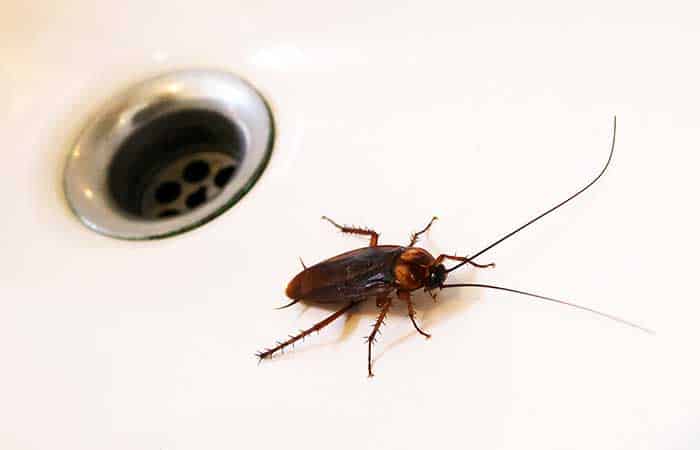
The Head of a Cockroach Explained
The head of a cockroach is small, downward bent, and holds its antennae, eyes, mouthpart, and part of its nervous system. You would think that this made it an important feature, but roaches can survive up to a week without their head! Their body is the nervous system’s primary location, which gives them the ability to live without their head. The headless cockroach dies after a week because it is unable to drink or eat.
The purpose of a cockroach’s antennae, which are also called antennal flagella, is to feel and smell the environment around them. The antennae look like threads but are made from tiny segments covered in hair. The segments are long and thin near the tips and shorter and narrower near the roach’s head. They regularly clean their antennae, but the reason for this remains a mystery to scientists.
Just like mammals, a cockroach uses its mouthpart for chewing, cutting, and grinding food. They even have two lips, which are called labium and labrum. As with most insects, the mouthpart points backward rather than forwards.
A cockroach has eyes that are compound and made of photoreceptor cells. These cells are called ommatidia and are surrounded by a rigid ring called the ocular sclerite. Cockroaches see the world as a mosaic due to the compound structure of the eyes.
The head has a small plaque on it, which is called the pronotum. The feature is essential because it contains the markings that allow us to differentiate one species from another.
The Wings of a Cockroach Explained
The majority of adult cockroaches have two pairs of wings, although they do not use them for flight. Cockroaches don’t tend to be good flyers, and some can’t fly at all. The ones that fly can only glide for a very short period, from one spot to another.
Some species, however, are strong and capable flyers. Species of cockroaches capable of flight include American cockroaches, Oriental cockroaches, Australian cockroaches, and Smoky Brown cockroaches.
Young cockroaches, which are called nymphs, cannot fly because they have not yet developed wings.
The mesothoracic fore wings of a cockroach are called wing covers, elytra, or tegmina. These serve a protective function and cover the hindwings. They are leathery, stiff, opaque, and dark in color, and they play no role in flight.
The hind wings of a cockroach are thin, large, transparent, and membranous. Cockroaches keep these folded below the tegmina, and some species use them for flight. When a cockroach is preparing to take flight, it lifts its front wings to expose the hind ones. While in flight, it keeps its front wings lifted to use the hind ones to move through the air.
Cockroach flight is uncommon because it is much more efficient and fast for them to use their legs to crawl (remember how a cockroach can reach speeds of fifty body lengths per second due to its rear legs).
Flying is challenging for cockroaches both because their heads are small compared to their bodies and because they only use one set of their wings for flight.
Other distinctive features of a cockroach
Most cockroaches are either black, brown, reddish-brown, or tan. They have two long antennae. If you can get close enough to examine a cockroach, you will notice a small pair of filaments like tendrils at its base, which are called cerci. Close examination of a female cockroach may reveal an egg case protruding from behind, which looks like part of its body from a distance.
It is difficult to identify a cockroach by its size as this varies widely between different roach species. The German cockroach is tiny and only grows to about half an inch long. The American cockroach is much larger, reaching around two inches in length when fully grown.

How to Tell the Difference Between Cockroaches and Beetles
Like cockroaches, beetles have spiny legs, but they tend to be shorter in comparison. Ground beetles, which can be household pests like cockroaches, have pincers on their mouth, which cockroaches do not have. Beetles are also more adept at flight than cockroaches, so if the bug you are trying to identify is flying around, it is more likely a beetle. Cockroaches prefer to crawl around, as discussed in the earlier section on wings.
How to Tell the Difference Between a Cockroach and a Cricket
It is easier to tell the difference between a cricket and a cockroach compared to a beetle. Crickets have substantial hind legs, which they use to hop long distances and make their signature chirping sound.
One cockroach species – the Hissing cockroach – is more frequently confused with crickets because it makes a hissing sound. However, this cockroach does not use its hind legs like the cricket to make this sound. Instead, it has holes in its body called spiracles, and it makes the sound by forcing air through them. The sound helps scare predators and warn its fellow roaches of danger, but it is unique to this particular cockroach species.
A cricket’s body is not as flat as a cockroach’s, which uses it to squeeze through tiny crevices. Crickets also tend to have more oversized heads than a cockroach.
How to Identify a Cockroach
Now you know more about their anatomical features, it will be easier to identify them. You would need to see one up close, though, to be sure it is a cockroach. Sticky traps can help you to catch, identify, and kills unwanted insects in your home.
Sticky traps are an effective and inexpensive pest control product that you can buy commercially. If you place a sticky trap close to the area of a suspected cockroach sighting, chances are the bug will get trapped in it, and then you can inspect its anatomy to determine if it is a cockroach or something else.
Try to place your traps in a relatively hidden place, out of the way, as cockroaches don’t like to venture out in the open if they can help it. Good candidates for traps are under or near furniture or appliances or close to holes in the walls. Think about where insects might be most likely to hide and place several around the room or home.
Cockroaches are nocturnal and more likely to venture out at night so leave the traps out to check for specimens in the morning.
Conclusion on How Many Legs Do Cockroaches Have
As you can see, cockroaches have a distinctive anatomical structure. While there are some differences in various cockroach types’ – outward appearance such as size and color – their anatomy is very similar.
Their anatomy makes it easier to identify them regardless of the particular cockroach species. The design of their six legs makes them extremely fast and challenging to catch.
While the wings are pretty useless for most roach species, their ability to regrow legs and survive without their head makes them more formidable than many other insects. If you spot one, act fast to prevent a more extensive infestation.

